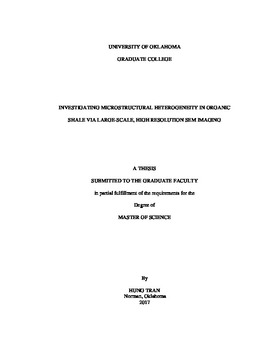| dc.description.abstract | The physical properties of shale are fundamentally controlled by its microstructure; however, shale is problematic due to microstructural heterogeneity that can exist across multiple scales. This creates difficulty in determining a representative sample size for imaging as well as petrophysical measurements. Utilizing large area, high-resolution SEM imaging, appropriate representative elementary areas (REA) are determined for imaging and analysis. Imaging has been performed on contiguous regions of a 1 ft long section of Wolfcamp Shale core. The porosity and organic matter content of this area has been segmented, analyzed and are reported as bounded values. Pore size distributions and pore areal contributions have been calculated from these data. Measurements on sampling size suggest that the REAs needed for analysis differ for various microstructural components of interest (e.g. the size of the image required for analysis of pores is much smaller than that needed to analyze organic matter). Variations of REAs are reported for porosity and TOC of different samples along the 1 ft Wolfcamp Shale core section. REAs for samples of this core section range from 0.2 - 0.8 mm2 for analysis of pores and from 0.6 – 1.2 mm2 for analysis of organic matter.
Grain size of shale controls multiple properties of the formation such as gross gamma ray response, thermal properties, elastic properties, and hydraulic properties. In addition, grain size can provide information about the depositional environment that can be crucial to determine “sweet spots” for hydrocarbon exploration. In this research, an approach to analyze grain size distribution is developed. Initially, minerals can be grouped into four categories based of their grayscale values in 8-bit backscattered electron tif images. Appropriate representative elementary area (REA) of each mineral group is estimated for imaging and analysis. The aspect ratio of clay minerals can be used to distinguish them from these groups. In addition, watershed segmentation techniques are applied to the images to further the grain size distribution. Orientation study is performed for these clay grains to determine the trend of grain alignment, which is strong indication of shale anisotropy. It is confirmed by the velocity measurements conducted on samples within a 195 ft interval located in the same well.
When comparing with the petrophysical measurements of porosity and organic matter content, the result shows a strong correlation between these petrophysical measurements (crushed helium porosity and TOC) and the SEM measurements (porosity and organic content) even though the unit bases are quite different. I compare SEM pore size distribution with MICP and MNR data. The information obtained from this study has two important implications: 1) it defines the imaging scale required to extract useful information about porosity and organic matter and 2) it provides a method for grain size analysis in shale. | en_US |
